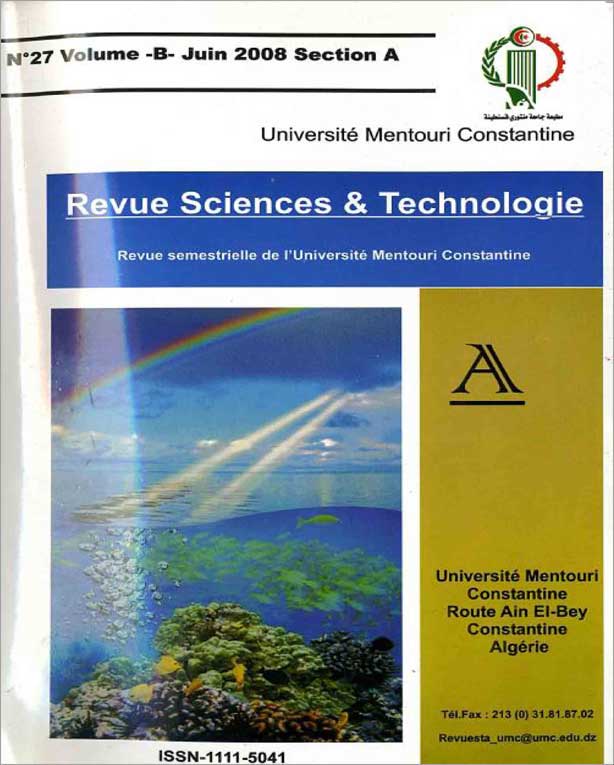DEGRADATION DU 2,6-DIMETHYLPHENOL PAR LES DEUX PROCEDES FENTON (H2O2/Fe2+) ET PHOTOFENTON (H2O2/Fe2+/UV)
Keywords:
2, 6-diméthylphénol, radicaux hydroxyle, dégradation, Fenton, photoFenton, mécanisme réactionnelAbstract
la dégradation du 2,6-diméthylphénol (concentration initiale de 5x10-4 M) un des dérivés phénolique utilisé comme intermédiaire dans la fabrication de plusieurs produits industriels comme les résines, les antioxydants, les désinfectants et les vernis a été étudiée par les deux procédés Fenton (H2O2/Fe2+) et photo-Fenton (H2O2/ Fe2+ /UV). Les réactions ont étéréalisé avec les rapports [H2O2]0 / [Fe2+]0 = 0,5, 1 et 2, la concentration du 2,6-DMP étant identique à celle de Fe2+ (5x10-4 M). Le taux d’abattement du 2,6-DMP est de 46 %, 68 % et 80 % pour les rapports 0,5, 1 et 2 respectivement avec le réactif de Fenton. Cependant nous avons remarqué une accélération de la disparition du 2,6-DMP par irradiation du réactif de Fenton à 365 nm qui est attribuée à la production supplémentaire de radicaux HO•. Cette production résulte de la photoréduction des ions ferriques formés dans l’étape antérieure de décomposition de H2O2 par les ions ferreux (réaction de Fenton). L'irradiation du réactif de Fenton à 254 nm et à 365 nm a montré une dégradation totale du 2,6-DMP à 365 nm, alors qu'a 254 nm le taux d’abattement est de 50 % au bout de 20 minutes d’irradiation et atteint un pallier à cause de la consommation totale de H2O2. La cinétique
de disparition du 2,6-diméthylphénol a été suivie par HPLC ou un nombre d'intermédiaires a été détectés et un mécanisme réactionnel est proposé.
Downloads
References
Daneshvar N., Salari D. et Khataee A.R, Photocatalytic degradation of azo dye Acid Red 14 in water: investigation of the effect of operational
parameters, J. Photochem. Photobiol. A 157 111–116 (2003).
Lukes P., Water Treatment by pulsed streamer corona discharge, Institute of Plasma Physics ASCR, Prague, Czech Republic, (2001).
Tarr M.A., Fenton and modified Fenton methods for pollutant degradation, in: M.A. Tarr (Ed.), Chemical degradation methods for wastes and pollutants –environmental and industrial applications, Marcel Dekker
Inc., New York, USA, 165–200 (2003).
Fenton H.J.H.; J. Chem. Soc., 65, 899 (1949).
Haber F. et Weiss J.; Proceding of the Royal Society, A 147, 332-351 (1934).
Buxton G.U., Greestock C.L., Helman W.P. et Ross A.B.; J. Phys. Chem., 17, 2, 513-886 (1988).
Barb G.W., Baxendale J.H., Goerge P. et Hargrave K.R.; Nature, 163, 692-694 (1949).
Heinsenhauer H.R.; J. Water Poll. Control Fed., 36, 9, 1116-1128 (1964).
Keating E.J., Brown R.A. et Greenberg E.S.; Proc. 33th Ind. Waste Conf. Purdue Univ., 464-470 (1978).
Sedlaket L.D. et Andrew W.A.; Environ. Sci. Technol., 25, 4, 777-782 (1991).
Al-Hayek N.; Thèse de Doctorat, Univ. de Poitiers, n° 408 (1985).
Langford C.H. et Caray J.H., J.Chem, 53, 2430-2435 (1975).
Faust B.C. et Hoigné J., Atmospheric Environment, 24A, 79-89, (1990).
Knight R.J. et Sylva R.N., J. Inorg. Nucl. Chem., 37, 779, (1975).
Kouachi N. et Sehili T.; Technol. Environ. Chem., 68, 141-157 (1999).
Tanger W. Z. et Huang C.P., Hazardous. Ind. Wastes, 26, 212-220, (1994).
Terzian R., Serpone N. et Fox M. A., J. Photochem. Photobiol. A : Chem., 90, 125, (1995).







